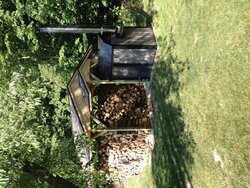Hello all, I have been a long time reader of the site but have never came "out of the closet" until now. I read on this site about folks using 500, or 1000, or sometimes more of "storage" for their heating systems. I am curious what kind of realized effiecncy savings "wood consumption" you have actually seen with these systems. I am curious to understand what quantity of wood you were burning in an average winter before the addition of storage, or how the addition of additional storage into your systems improved your efficency. I understand the reasons that you choose to do storage, with single extended burns but want to know how much you have actually saved in consumption.
I have been heating my home for the last 4 seasons with a Central Boiler 5036. I see on here that many of you folks favor gassers and I appreciate that. For my situation the boiler that I have fits my needs perfectly. It keeps my 2300 SQ. FT house 74 degrees with infloor heat on about 8 cords of mixed wood a year. I generally run lesser quality wood in low heat demand times (pine, basswood, box elder) and the good stuff when it is needed (ash, hard maple, hickory, elm).
Fill me in, I'm listening.
I have been heating my home for the last 4 seasons with a Central Boiler 5036. I see on here that many of you folks favor gassers and I appreciate that. For my situation the boiler that I have fits my needs perfectly. It keeps my 2300 SQ. FT house 74 degrees with infloor heat on about 8 cords of mixed wood a year. I generally run lesser quality wood in low heat demand times (pine, basswood, box elder) and the good stuff when it is needed (ash, hard maple, hickory, elm).
Fill me in, I'm listening.





